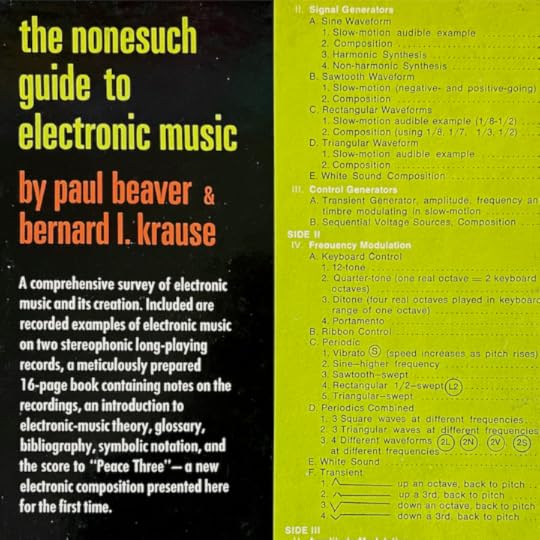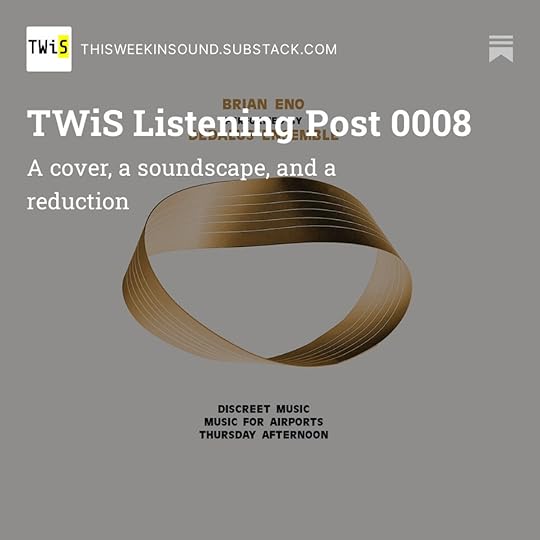Marc Weidenbaum's Blog, page 97
August 5, 2023
Scratch Pad: Timing, AudioMoth, Foghorns
I do this manually at the end of each week: collating most of the recent little comments I’ve made on social media, which I think of as my public scratch pad. I used to do this on Saturday mornings over coffee, but it recently became clear to me that that timing is counterproductive, since I aim to take weekends off social media — thus, doing this chore on Saturday morning meant pulling up social media on Saturday morning, which is not what I want to be doing. So, now I’m collating late Friday afternoon, and then posting on Saturday morning. As for social media, these days I mostly hang out on Mastodon (at post.lurk.org/@disquiet), and I’m also trying out a few others.
▰ A privacy filibuster: Based on the appearance of “” in automated transcriptions of human speech, the best current way to keep AI/ML from comprehending a conversation is for an additional person to speak continuously at the same time in a way the others can just ignore.
▰ My phone is set to a voice (South African, according to fruit company linguists). When I decline to reply to a text message, it says “OK,” which always sounds like it’s in on some unspoken meaning I’ve thus telegraphed. It sounds like what it means is “OK, you cheeky monkey.”
Also, I realize that the word “telegraph” has itself long since transformed from an actual form of direct communication to a synonym for suggesting something indirectly.
▰ This is aimed an no one in particular: there’s rarely reason to follow-up about an album you’ve asked me to write about, and much as I try for it not to affect me, after three or four emails, the correspondence does begin to negatively impact the likelihood of what you’re asking.
▰ Between June 23 and August 4 I used the AudioMoth for 14 overnight recordings of five to six hours each night (half indoors, half out), yielding over 26 gigabytes of sound, on just three AA batteries. And far as I can tell, the batteries still have about half a charge. Amazing.
▰ This is incredibly obvious, but only today during guitar class did it occur to me that when I move chords in a major scale up and down the fretboard, each string is in its own mode. (I can be a slow learner.)
▰ Moved to Obsidian.md from IA Writer for markdown and general note-taking. So far it’s nice: elegant, solid, customizable. (Side note: I love that a 1994 decision to use .md as Moldova’s top-level domain led to it being a favorite of medical professionals and coders.)
▰ Summer in San Francisco is foghorn mating season
August 4, 2023
1968 Was a Good Year

A friend gave me this 1968 two-LP set as a present, and you just have to love an album with track titles that include waveforms.
August 3, 2023
Disquiet Junto Project 0605: Fifty Fifty

Each Thursday in the Disquiet Junto music community, a new compositional challenge is set before the group’s members, who then have just over four days to upload a track in response to the assignment. Membership in the Junto is open: just join and participate. (A SoundCloud account is helpful but not required.) There’s no pressure to do every project. It’s weekly so that you know it’s there, every Thursday through Monday, when you have the time and interest.
Deadline: This project’s deadline is the end of the day Monday, August 7, 2023, at 11:59pm (that is, just before midnight) wherever you are. It was posted on Thursday, August 3, 2023.
Tracks are added to the SoundCloud playlist for the duration of the project. Additional (non-SoundCloud) tracks appear in the lllllll.co discussion thread.
These following instructions went out to the group’s email list (at tinyletter.com/disquiet-junto).
Disquiet Junto Project 0605: Fifty Fifty
The Assignment: Compose a piece of music with as much silence as notes.
There’s just one step to this project:
Compose a piece of music with as much silence as notes.
(Thanks to Jason Richardson for having proposed it.)
Eight Important Steps When Your Track Is Done:
Step 1: Include “disquiet0605” (no spaces or quotation marks) in the name of your tracks.
Step 2: If your audio-hosting platform allows for tags, be sure to also include the project tag “disquiet0605” (no spaces or quotation marks). If you’re posting on SoundCloud in particular, this is essential to subsequent location of tracks for the creation of a project playlist.
Step 3: Upload your tracks. It is helpful but not essential that you use SoundCloud to host your tracks.
Step 4: Post your track in the following discussion thread at llllllll.co:
https://llllllll.co/t/disquiet-junto-project-0605-fifty-fifty/
Step 5: Annotate your track with a brief explanation of your approach and process.
Step 6: If posting on social media, please consider using the hashtag #DisquietJunto so fellow participants are more likely to locate your communication.
Step 7: Then listen to and comment on tracks uploaded by your fellow Disquiet Junto participants.
Step 8: Also join in the discussion on the Disquiet Junto Slack. Send your email address to marc@disquiet.com for Slack inclusion.
Note: Please post one track for this weekly Junto project. If you choose to post more than one, and do so on SoundCloud, please let me know which you’d like added to the playlist. Thanks.
Additional Details:
Length: The length is up to you.
Deadline: This project’s deadline is the end of the day Monday, August 7, 2023, at 11:59pm (that is, just before midnight) wherever you are. It was posted on Thursday, August 3, 2023.
Upload: When participating in this project, be sure to include a description of your process in planning, composing, and recording it. This description is an essential element of the communicative process inherent in the Disquiet Junto. Photos, video, and lists of equipment are always appreciated.
Download: It is always best to set your track as downloadable and allowing for attributed remixing (i.e., a Creative Commons license permitting non-commercial sharing with attribution, allowing for derivatives).
For context, when posting the track online, please be sure to include this following information:
More on this 605th weekly Disquiet Junto project, Fifty Fifty (Compose a piece of music with as much silence as notes), at: https://disquiet.com/0605/
Thanks to Jason Richardson for having proposed this week’s project.
About the Disquiet Junto: https://disquiet.com/junto/
Subscribe to project announcements: https://tinyletter.com/disquiet-junto/
Project discussion takes place on llllllll.co: https://llllllll.co/t/disquiet-junto-project-0605-fifty-fifty/
August 2, 2023
TWiS Listening Post 0008

This went out today as a weekly bonus — a thank-you to people who financially support This Week in Sound. It’s a supplement to the free Tuesday and Friday issues: an annotated playlist of recommended music. I wrote about (1) a cover of Brian Eno (more on which below), (2) a soundscape by Irene Buckley (working in collaboration with the dance company Junk Ensemble), and (3) and Aphex Twin cover by classical guitarist Simon Farintosh.
While the weekly Wednesday issues are intended for paid subscribers, I did want to share one of the items here. This is on the Eno covers album:
SPACE MUSIC: It’s an irony of artistic achievement that great success eventually engenders tributes that fall well short of the subject at hand. It’s an additional irony in the case of Brian Eno that this musician who helped truly usher in the concept of the studio as a musical instrument might find his work reproduced in a manner — that is, with live instrumentation — that his own techniques served to supplant, even to upend. It’s not that the connection between Eno’s ambient music and classical chamber music is unfounded. Quite the contrary, the story goes that his composition of the album Discreet Music was informed by harp music playing all too quietly in the background. Likewise, the full second side of that ur-ambient album consists of variations on one of the great warhorses of classical music, Pachelbel’s Canon. Still, it’s with some deserved trepidation that the admiring listener approaches the classical world’s occasional take on Eno’s music, because so much of what distinguishes it is the very thing that classical music often can’t abide, which is the texture of the sound itself.
All of which is why Performing Brian Eno: Discreet Music/Music for Airports/Thursday Afternoon, on the great Sub Rosa record label, by the Dedalus Ensemble, is such a treat. It opens with a segment of Thursday Afternoon, at 15 minutes long barely a quarter of the original. What makes it work so well is how much it gestures toward texture, the way the strings achieve the droning room tone of the source material. The liner notes by Didier Arschour expertly pinpoint how “natural acoustics and spatialization replace the studio effects that characterized the original recordings, strikingly enriching the acoustic space and reinforcing the hypnotic and immersive aspects of these works.” In other words, what began in the studio still is music of an interior physical space. Also on the record, renditions of Discreet Music and Music for Airports. The ensemble is Aschour, guitar, arrangements and artistic direction; Denis Chouillet, piano ; Amélie Berson, flute; Fabrice Villard, clarinet; Pierre-Stéphane Meugé, saxophone; Christian Pruvost, trumpet; Thierry Madiot, trombone; Silvia Tarozzi, violin; Cyprien Busolini, viola; Deborah Walker, cello; Eric Chalan, double bass & vibraphone. (Album found via Warren Ellis’ newsletter.)
This Week in Sound: “Nightingales Perform These Songs in Duels to Defend Territory”

These sound-studies highlights of the week originally appeared in the August 1, 2023, issue of the Disquiet.com weekly email newsletter, This Week in Sound. This Week in Sound is the best way I’ve found to process material I come across. Your support provides resources and encouragement. Most issues are free. A weekly annotated ambient-music mixtape is for paid subscribers. Thanks.
▰ ALL ATWITTER: “Male nightingales have very large repertoires of up to 150 to 200 different song types, one of which is known as a whistle song. During the mating season, male nightingales perform these songs in duels to defend territory and attract mates, sometimes for many consecutive nights. … [Researchers] found that nightingales flexibly adjusted the pitch of their whistle songs to match that of their opponent. When the researchers played pitch-controlled artificial whistle sounds from speakers, the nightingales also matched their pitch to these across a wide range of frequencies.”
▰ APPLE RECORDS: Apple filed for a head-turning, turntable-related patent: “In the patent, first filed in June of 2021 and approved Tuesday, Apple talks up its ideas for ‘Modularized Computing and Input Devices.’ This kind of kickstand would act as a kind of slotted dock that could accept multiple screens and keyboards, and potentially more. It’s all configured around some kind of base device that can connect both displays or keyboards in multiple configurations. The base itself would be hinged to allow these devices to swivel. … One of the funkiest aspects of the patent is the inclusion of a large, classic-style vinyl turntable. The application itself describes this as merely an ‘input device’ that can provide information to the base. Essentially, the base would allow physical or wireless communication with the attached device, in this case, a turntable usable by ‘disc jockeys,’ or anybody working the decks on their device.”

▰ SPACE OUT: The use of sonification remains a somewhat conflicted topic — often the question is: is it science, or just public relations? Take the case of research from Northwestern University that led to a sonic exploration of the “twinkle” of stars: “the team also converted these rippling waves of gas into sound waves, enabling listeners to hear both what the insides of stars and the twinkling’ should sound like.” (Thanks, Gene Kannenberg, Jr!) … Even more interesting: “a musical piece written for a small wind ensemble based on one year of wind data collected by the satellite” Aeolus, which “will die in a fiery first-of-its-kind reentry this week.” This work involved composer Jamie Perera.
▰ STABLE FOR DAYS: “[I]n a car, sound waves may have to travel from the lower doors, front kick-panels, or the trunk, bouncing off plastic, carpet, leather, fabric, glass, and more before reaching a listener’s ear. Sound from one speaker can also interfere with that of another — a problem that can be made worse by increasing the number of in-car speakers. Dirac’s audio magic is all ones and zeros — digital signal processing software that helps virtually align and equalize these sound paths—and it’s designed to work with anyone’s speakers. … Researchers there determined that any speakers in any space could be made to sound better if the signals driving those speakers were conditioned to work collaboratively with one another, and that, when tailored to the specifics of the space, those collaborative signals could even make the sound seem as though it was arriving at listeners’ ears as if from unobstructed speakers in a studio.” Read up on Dirac’s “Intelligent Audio Platform” in Motor Trend.
▰ TEAR IT UP: Jennifer Krasinski in Artforum on the role of sound in the sculptures of artist-composer Camille Norment (Oslo-based, American-born): “One way to ‘share this resonance’ (as Norment prompts) is modeled by Untitled (Bellhorn), 2022, a shining, magisterial brass sculpture installed in the middle of an otherwise empty gallery. About five feet tall, its form is like the horn of an oversized tuba, seamlessly closed off at one end to balance upright, its wide maw open to the ceiling. Suspended just above is a long, thick thread that gathers into a molten, lacrimoid pendant, in which Norment has hidden a speaker. Four microphones point from the four corners of the room toward the sculpture, recording the ambient sounds of the visitors and the room — bits of conversation, footsteps, the rustling of clothing — all fed into the speaker in loops which in turn echo inside Bellhorn’s mouth and beyond. Every sound is a record of the listener; every listener is permeated by their own sounds. As author and sound artist Jace Clayton noted about this work in his review of “Plexus,” Norment’s exhibition at Dia: ‘Feedback is machinery saying “I Am that I Am.”’ Feedback is also architecture declaring the same, or at least rounding out the chorus. Less audible, perhaps, but no less present, are context’s effects and distortions.”
▰ QUICK NOTES: Making Waves: On the role of cruise ships in ocean noise. ▰ Broken 45: “In his news conference, which just ended, Jack Smith spoke barely above a whisper. The sound crews recording him complained after he left that it had been hard to find a good volume level.” That’s a post from reporter Glenn Thrush at the New York Times regarding the August 1 indictment press conference. ▰ Blipverts 2.0: A distinction really needs to be made between the broader implications of sonic branding and the narrower matter of audio (or sonic) logos, which Washington Post classical critic Michael Andor Brodeur aptly describes as “highly concentrated jingles” (thanks, Mike Rhode!) ▰ Found That Number: In related news, a jingle written for the beer Schlitz by Steely Dan — a band more closely associated with “the Cuervo Gold, the fine Colombian” — has surfaced. ▰ Double Nickels on the Dime: And, check out the new sonic logo of the AA (that is, the automotive services company), which uses “strong bass and percussions … to evoke a feeling of safety.” ▰ Block Chain: “Counties in the state of Arkansas are scrambling to pass emergency legislation to regulate the noise levels of BTC block reward miners amid a looming new law that would protect the miners from being singled out through targeted legislation. ▰ Mouthing Off:An experiment with the upcoming iOS 17 “voice replication technology” was able “to trick a phone banking voice authentication system.”
August 1, 2023
Sound Ledger
50: Upward bound, in percentage, of dogs that are afraid of fireworks
200: Upward bound of the number of songs in the repertoire of a male nightingale
4,000: Upward bound, in euros, of a fine in Portugal for playing music on a portable loudspeaker outdoors too loudly
On the Line: Transcription, Clocks, Birding
That is Brooklyn, New York–based Ethan Hein on the process of transcribing some classic jazz.
. . .
“I’m still a slave to the clock despite all my attempts to break free from it.”That is a Melbourne, Australia–based musician, who goes by the name branch, on the topic of the absence of clock syncing in a piece of music-making software.
. . .
“Then, like scanning through the quiet static of a radio band, I began to notice the birdsong.”That is Tristan Louth-Robins recounting a field recording visit to Australia’s Kangaroo Island.
July 31, 2023
Thief

Fish and Shrimp Thief totally sounds like the name of an early-’90s Ninja Tune electronica act I forgot about in the intervening decades. However, the name is not taken, so go at it.
Side Trip

Got to see Joan Jett. So much fun. Been reading up on Kenny Laguna, her Blackhearts cofounder, who had two moments in the spotlight at his keyboards during the show to talk a bit about this rock and roll legend. He’s something of a legend himself. And she exudes ease, power, and joy. (For context: the vast majority of the show didn’t have her face projected in the background. This was during the song that was the theme song the guitarist wrote for the Bad Reputation documentary.)
July 30, 2023
On Repeat: Rain, Sinéad O’Connor, More
I try to at least quickly note some of my favorite listening from the week prior — things I’ll later regret having not written about in more depth, so better to share here briefly than not at all.
▰ “There are cars, pigeons and aircraft!” warns Mark David Hadley in a brief liner note for his collection Recordings of the Rain, which contains exactly that. Also: church bells. “Metal Garden Chair 3” is a banger.
https://soundbymark.bandcamp.com/album/recordings-of-the-rain
▰ I mentioned recently the phenomenon of doing some research while writing a review of a concert and stumbling on a video of that very same concert. This is one of the four sets from a great recent show I saw here in San Francisco. The quartet, playing a kind of ambient chamber jazz, is Ross Hoyt, keyboards, electronics; Ryan Honaker, violin, electronics; Leila Abdul-Rauf, trumpet, voice, electronics; and Ed Lloyd, contra bass. Pay attention particularly to Abdul-Rauf, who runs her voice thorugh the same technology that transforms her trumpet. The music is apparently all drawn from Hoyt’s upcoming album, Peregrinari.
▰ And let’s be honest, I spent much of the week listening to the late Sinéad O’Connor. Her debut record, The Lion and the Cobra, came out at the start of my senior year of college. She was barely four months younger than I am. To suggest she had an impact on my Gen X cohort would be an understatement. More specifically in the context of the sort of music I focus on at Disquiet.com, her version of the 17th-century Irish poem “I Am Stretched on Your Grave,” with an underlying Amen break augmented by bass line and fiddle, off I Do Not Want What I Haven’t Got, her sophomore album, came out in 1990. That’s the same year as Enigma’s “chant and beat” MCMXC a.D (brainchild of Michael Cretu, a decade older). This left a mark, and we’re all the richer for it. Fold in Dead Can Dance’s own cover of “I Am Stretched on Your Grave,” a few years later on Toward the Within (1994), and these seeds — among many others — of cultural impact are pretty clear.



